Team designs twist on software

Manual manipulation of ShapeTape <br>(Image: Ravin Balakrishnan)
Virtual shapes created on a computer screen by manipulating ShapeTape, a flexible tape-like tool
U of T researchers have created software that will enable users to twist, bend, push and pull shapes in two and three dimensions.”
Our work represents a completely different way of interacting with computers,” says Professor Ravin Balakrishnan of U of T’s Department of Computer Science, who led the research. “It moves away from the ’one-size-fits-all’ keyboard and mouse paradigm to more specialized tools for specialized tasks.”
The team’s software allows users to create virtual shapes on a computer screen by manipulating a flexible tool called ShapeTape in tandem with a foot pedal. ShapeTape, which looks like a long rubber ribbon, has a spring steel core and is embedded with fibre optic sensors. The tape, which is physically held in both hands, can be twisted and bent to change sizes and shapes on screen. It can also locate shapes in three dimensions. “We’re able to do more things in the virtual world,” says Balakrishnan, “while still maintaining a connection to the physical world.”
Balakrishnan says the ShapeTape software could be used to design and refine technical drawings of virtually any product, including computers and cars. The research appears in the Association of Computing Machinery’s Computer-Human Interaction Letters, Volume 5, Issue 1.
Nicolle Wahl is a news services officer with the department of public affairs.
CONTACT:
Professor Ravin Balakrishnan, Department of Computer Science, ph: (416) 978-5359; email: ravin@cs.toronto.edu
U of T Public Affairs, ph: (416) 978-6974; email: nicolle.wahl@utoronto.ca
Media Contact
More Information:
http://www.newsandevents.utoronto.ca/bin4/030415d.aspAll latest news from the category: Information Technology
Here you can find a summary of innovations in the fields of information and data processing and up-to-date developments on IT equipment and hardware.
This area covers topics such as IT services, IT architectures, IT management and telecommunications.
Newest articles

Solving the riddle of the sphingolipids in coronary artery disease
Weill Cornell Medicine investigators have uncovered a way to unleash in blood vessels the protective effects of a type of fat-related molecule known as a sphingolipid, suggesting a promising new…

Rocks with the oldest evidence yet of Earth’s magnetic field
The 3.7 billion-year-old rocks may extend the magnetic field’s age by 200 million years. Geologists at MIT and Oxford University have uncovered ancient rocks in Greenland that bear the oldest…

Decisive breakthrough for battery production
Storing and utilising energy with innovative sulphur-based cathodes. HU research team develops foundations for sustainable battery technology Electric vehicles and portable electronic devices such as laptops and mobile phones are…





















